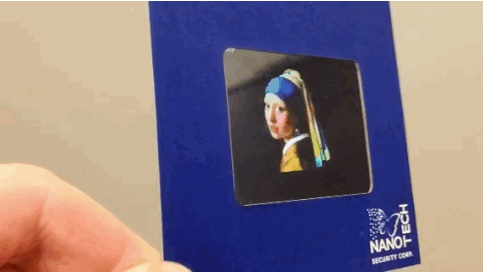First featured here in a January 17, 2011 posting about proposed anti-counterfeiting measures based on the structures present on the Blue Morpho butterfly’s wings, NanoTech Security is the subject of a profile in the Vancouver (Canada) Sun’s Dec. 28, 2015 Technology article by Randy Shore.
They’ve managed to get themselves into the newspaper without having any kind of real news, research or business, to share. As is so often the case, timing is everything. This is a low news period (between Christmas and New Year) and the folks at NanoTech Security got lucky with a reporter who doesn’t know much about the company or the technology. When you add in low public awareness about the company and its products (you couldn’t do this with a company specializing in a well established technology, e.g., smartphones), there’s an opportunity.
Getting back to Shore’s Dec. 28, 2015 Technology article in the Vancouver Sun,
Landrock [Clint Landrock], the chief technology officer at Burnaby-based [Burnaby is a municipality in what’s known as Metro Vancouver] Nanotech Security Corp., has spun off his SFU [Simon Fraser University] research to found the firm, which is developing nano-optics for the global battle against counterfeiters.
Colour-shifting holographic images, used as counterfeit protection on many banknotes, use technology that has been around for more than 35 years and they are increasingly easy to reproduce. Talented hobbyists can duplicate simple holographic features and organized criminals with deeper pockets can reproduce more sophisticated features with the right equipment.
…
Nanotech Security hopes to take a quantum leap ahead of forgers.
The detail and colour reproduction possible in Nanotech’s KolourOptick are dramatically better than the holographic images used on banknotes.
“We can improve a lot on those, by making the image a lot brighter, have a lot more detail and make it easy to view,” said Landrock. “When you try to fake that, it’s much more difficult to do and when you see a fake it looks fake.”
“Right now, the fake holograms often look better than the real thing,” he said.
Tiny structuresWhat [sic] Landrock found on the wings of the Blue Morpho was a lattice of tiny treelike structures that interact with light, selecting certain wavelengths to create a bright blue hue without pigments.
This ‘origins’ story includes a business mastermind, Doug Blakeway, and the researcher (Bozena Kaminska) under whose supervision Landrock did his work. Blakeway provides a somewhat puzzling quote for Shore’s story,
“I love nanotechnology, but I really have not seen a commercialization of it that can make you money in the near term, [emphasis mine]” said Blakeway. “When this was initially presented to me by Bozena and Clint, I immediately saw their vision and they were only after one application — creating anti-counterfeiting features for banknotes.”
The three formed a private company and licensed the patents from SFU, which receives a three per cent royalty on sales of the technology created under its roof. …
I am perplexed by Blakeway’s ” … I really have not seen a commercialization of it that can make you money in the near term” comment. There are many nanotechnology-enabled products on the market ranging from coatings for superhydrophobic waterproofing products to carbon fibre-enhanced golf clubs to nanoscale chips for computers and components for phones to athletic materials impregnated with silver nanoparticles for their antibacterial properties (clothes you don’t have to wash as often) to cosmetics and beauty products, e.g., nano sunscreens, and there are more.
NanoTech Security’s recently released some information about their financial status. They must feel encouraged by their gains and other business developments (from a Dec. 17, 2015 NanoTech Security news release),
Nanotech Security Corp. (TSXV: NTS) (OTCQX: NTSFF), (“Nanotech” or the “Company”) today released its financial results for the fourth quarter and year ended September 30, 2015.
Strategic Highlights from 2015
Revenue increased to $5.2 million a 131% increase over 2014. Security Features contributed revenues of $3.1 million.
Gross margin improved to 43% up from 34% in the same period last year. The improvement reflects the increased mix of higher margin Security Features revenue.
Signed two banknote security feature development contracts. The contracts are with top ten issuing authorities to develop unique optically-variable security features for incorporation into future banknotes.
Strategic meetings with large international banknote issuing authority. The Company has been approached by a large international banknote issuing authority to deliver a large volume of Optical Thin Film (“OTF”), and partner with our KolourOptik™ technology. Management continues to devote a significant amount of time and resources in advancing these opportunities.
Private Placement. The Company completed a non-brokered private placement financing of $2.6 million in equity units at $1.00 each.
Signed an amending agreement related to the 2014 Fortress Optical purchase agreement. The amendment provides that 1.5 million of the 3.0 million shares held in escrow, pending certain sales milestones were released from escrow and the remaining 1.5 million shares were returned to the treasury. The overall effect of the amendment resulted in a gain of $1.5 million and cancellation of 1.5 million shares.
Demonstrated KolourOptik™ security feature on metal coins. The Company successfully applied nanotechnology images to metal coins in a production environment at an issuing mint.
Granted five new patents expanding the growing IP portfolio. Three patents relate to the Company’s next generation nanotechnology authentication features, and two provide increased protection for OTF.
I’m curious as to how much of their revenue is derived from sales as opposed to research funding and just how much money does a 43% increase in gross margins represent? (Or, perhaps I just need to get better at reading news about *companies* and their finances.) In any event, signing two contracts and gaining interest in applying the technology to metal coins must have been exciting.
This story goes to show that if you understand news cycles, have a little luck and/or know someone, and have a relatively unknown technology or product, it’s possible to get media coverage.
*’company’s’ corrected to ‘companies’.

